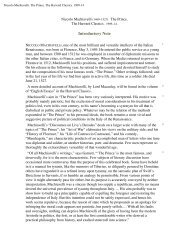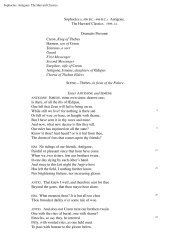Notre Dame de Paris - Bartleby.com
Notre Dame de Paris - Bartleby.com
Notre Dame de Paris - Bartleby.com
You also want an ePaper? Increase the reach of your titles
YUMPU automatically turns print PDFs into web optimized ePapers that Google loves.
even after verifying it with one’s own eyes. All the material, all the intellectual forces of society,<br />
converged to that one point—architecture. In this way, un<strong>de</strong>r the pretext of building churches to the glory<br />
of God, the art <strong>de</strong>veloped to magnificent proportions.<br />
In those days, he who was born a poet became an architect. All the genius scattered among the masses<br />
and crushed down on every si<strong>de</strong> un<strong>de</strong>r feudalism, as un<strong>de</strong>r a testudo of brazen bucklers, finding no outlet<br />
but in architecture, escaped by way of that art, and its epics found voice in cathedrals. All other arts<br />
obeyed and put themselves at the service of the one. They were the artisans of the great work; the<br />
architect summed up in his own person, sculpture, which carved his faça<strong>de</strong>; painting, which dyed his<br />
windows in glowing colours; music, which set his bells in motion and breathed in his organ pipes. Even<br />
poor Poetry—properly so called, who still persisted in eking out a meagre existence in manuscript—was<br />
obliged, if she was to be recognised at all, to enroll herself in the service of the edifice, either as hymn or<br />
prosody; the small part played, after all, by the tragedies of æschylus in the sacerdotal festivals of<br />
Greece, and the Book of Genesis in the Temple of Solomon.<br />
Thus, till Gutenberg’s time, architecture is the chief, the universal form of writing; in this stone book,<br />
begun by the East, continued by Ancient Greece and Rome, the Middle Ages have written the last page.<br />
For the rest, this phenomenon of an architecture belonging to the people succeeding an architecture<br />
belonging to a caste, which we have observed in the Middle Ages, occurs in precisely analogous stages<br />
in human intelligence at other great epochs of history. Thus—to sum up here in a few lines a law which<br />
would call for volumes to do it justice—in the Far East, the cradle of primitive history, after Hindu<br />
architecture <strong>com</strong>es the Phœnician, that fruitful mother of Arabian architecture; in antiquity, Egyptian<br />
architecture—of which the Etruscan style and the Cyclopean monuments are but a variety—is succee<strong>de</strong>d<br />
by the Greek, of which the Roman is merely a prolongation bur<strong>de</strong>ned with the Carthaginian dome; in<br />
mo<strong>de</strong>rn times, after Romanesque architecture <strong>com</strong>es the Gothic. And if we separate each of these three<br />
divisions, we shall find that the three el<strong>de</strong>r sisters—Hindu, Egyptian, and Roman architecture—stand for<br />
the same i<strong>de</strong>a: namely, theocracy, caste, unity, dogma, God; and that the three younger<br />
sisters—Phœnician, Greek, Gothic—whatever the diversity of expression inherent to their nature, have<br />
also the same significance: liberty, the people, humanity.<br />
Call him Brahmin, Magi, or Pope, according as you speak of Hindu, Egyptian, or Roman buildings, it is<br />
always the priest, and nothing but the priest. Very different are the architectures of the people; they are<br />
more opulent and less saintly. In the Phœnician you see the merchant, in the Greek the republican, in the<br />
Gothic the burgess.<br />
The general characteristics of all theocratic architectures are immutability, horror of progress, strict<br />
adherence to traditional lines, the consecration of primitive types, the adaptation of every aspect of man<br />
and nature to the in<strong>com</strong>prehensible whims of symbolism. Dark and mysterious book, which only the<br />
initiated can <strong>de</strong>cipher! Furthermore, every form, every <strong>de</strong>formity even, in them has a meaning which<br />
ren<strong>de</strong>rs it inviolable. Never ask of Hindu, Egyptian, or Roman architecture to change its <strong>de</strong>signs or<br />
perfect its sculpture. To it, improvement in any shape or form is an impiety. Here the rigidity of dogma<br />
seems spread over the stone like a second coating of petrifaction.<br />
On the other hand, the main characteristics of the popular architectures are diversity, progress,<br />
originality, richness of <strong>de</strong>sign, perpetual change. They are already sufficiently <strong>de</strong>tached from religion to<br />
take thought for their beauty, to tend it, to alter and improve without ceasing their garniture of statues and<br />
arabesques. They go with their times. They have something human in them which they constantly infuse










